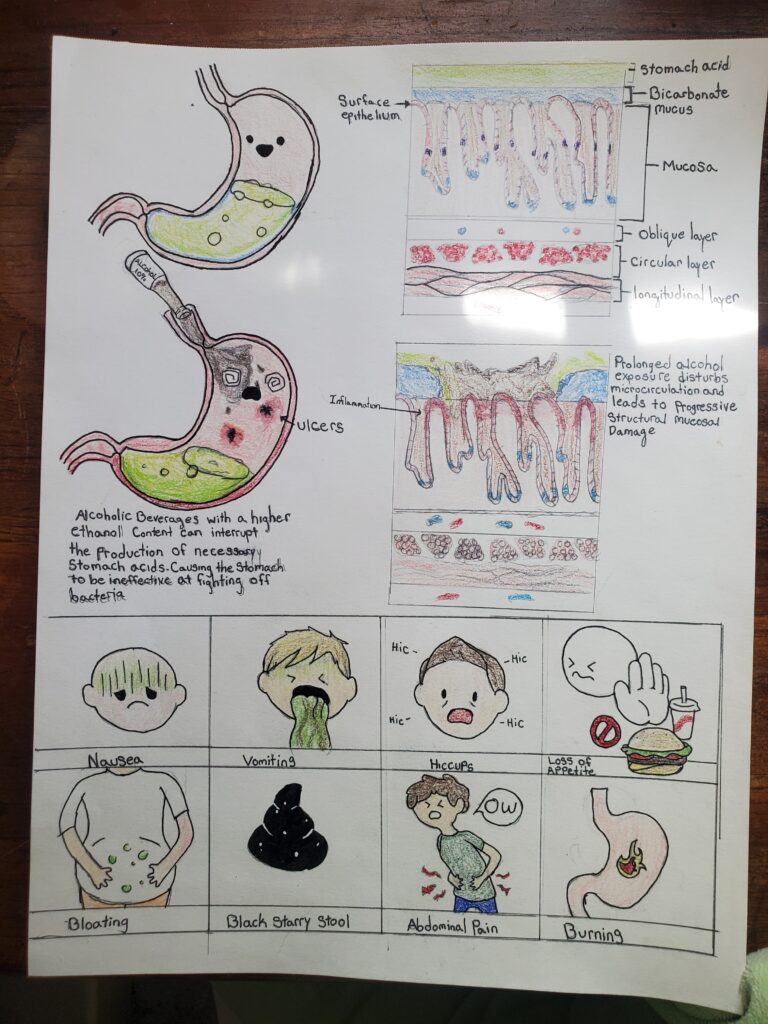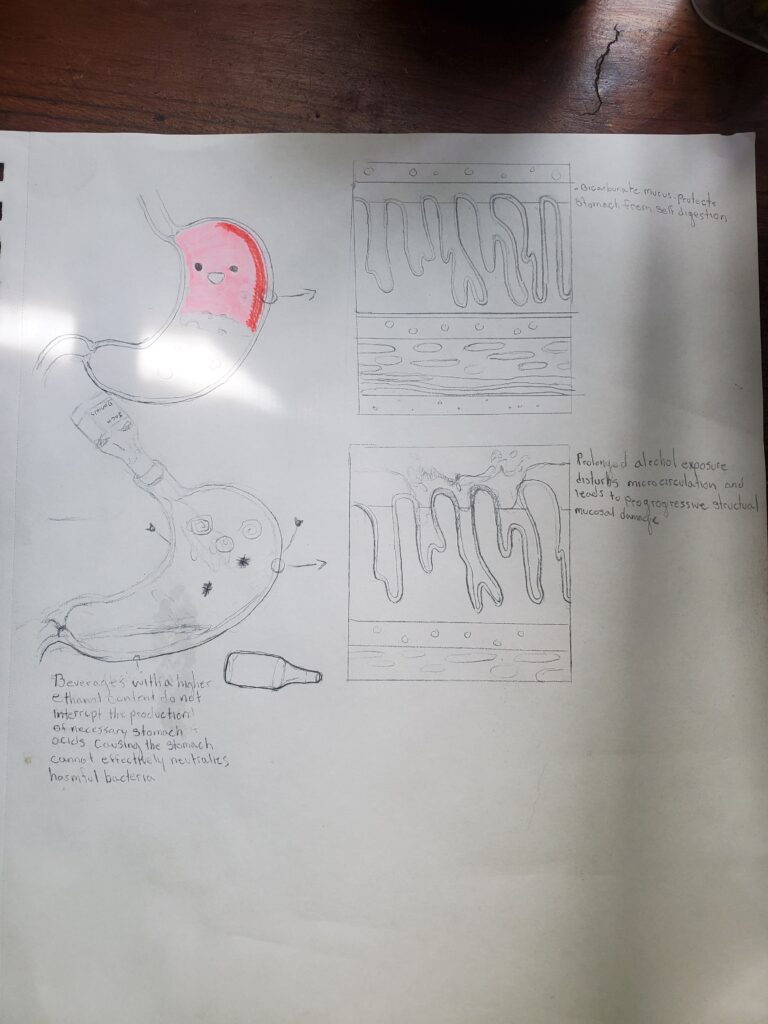For my project, I decided to make an infographic on how alcohol can affect the mucosa and damage the stomach lining. I drew and colored the stomach wall layer to show how the stomach wall is protected from stomach acids and show a comparison of how alcohol breaks through the mucosal barrier allowing stomach acid and bacteria to inflame the mucosa.
For my unit objective, I decided to “Know the tissues/cells and functions of the following: stomach, pancreas, liver, gallbladder, large and small intestine, and esophagus to these functions” Since I researched alcoholic gastritis I focused mainly on the stomach as that is the focal point for the illness.
The stomach is responsible for storing food in the fundus and mixing ingested food with hydrochloric acid and enzymes into chyme. It is exposed to highly corrosive acidic gastric juices. Gastric enzymes, such as pepsin, can digest protein and the stomach itself. To protect itself from self-digestion by the mucosal barrier, the stomach is lined with surface mucus cells which secrete a protective coat of bicarbonate-rich mucus. Below, epithelial cells of the stomach block gastric juices from penetrating the underlying tissue layer. Finally, stem cells are located where gastric glands join the gastric pits. Surface epithelial cells are quickly replaced by stem cells when damaged or every three to six days. The gastric glands are made up of different types of cells made up of a variety of secretory cells. Partial cells are located primarily in the middle region of the gastric glands. A relatively large cell is responsible for producing hydrochloric acid, a highly acidic stomach acid needed to activate the enzyme pepsin and kills most of the bacteria from ingested food.
Alcoholic Gastritis is a type of acute gastritis and is caused by excessive alcohol consumption. According to the CDC, excessive alcohol use includes Binge Drinking, which is four or more drinks consumed within two to three hours for women and five drinks for men; Heavy drinking which for women is eight or more drinks per week. For men, heavy drinking is 15 drinks or more per week; Underage drinking; and pregnant drinking. Gastritis occurs due to inflammation or swelling of the lining of the stomach. People with alcohol-associated gastritis may feel symptoms after an evening of binge drinking. Frequent consumption of alcohol does not allow the stomach to recover from the irritation to the lining. Partial cells, responsible for secreting hydrochloric acid, can become swollen and diminished due to alcohol exposure. This can disturb microcirculation and lead to progressive structural mucosal damage. Low doses of ethanol stimulate gastric secretion while high doses exert our inhibitory effect. This can leave the stomach defenseless from bacteria that enter with food alcohol interferes with the activity of muscles surrounding the stomach and may impair the muscle movement in the small and large intestines contributing to diarrhea. It is possible to treat alcohol-induced gastritis, for those who misuse or abuse alcohol one way to potentially reverse damage is to stop drinking, and, on some occasions, altering one’s diet can also help reduce symptoms. Other treatments can be antacids to neutralize the acid that is produced. Probiotics can encourage helpful gastric bacteria.
Sources:
Alcohol, glycine, and gastritis
https://journals.lww.com/ijnp/fulltext/2015/05010/Alcohol,_glycine,_and_gastritis.1.aspx
Alcoholic Gastritis: Eminence of Clinical Pharmacist to Attenuate Quality Of Life
Alcoholic Gastritis Causes, Symptoms & Treatment
https://alcohol.org/health-effects/gastritis
What is Excessive Alcohol Use?
Alcoholic disease: Liver and beyond
https://home.sandiego.edu/~josephprovost/alcohol%20disease%20liver%20and%20beyond.pdf




Shawnise’s project was on the effects of alcoholic gastritis on the stomach mucosa. The short essay states that consuming over the recommended amount of alcohol can cause serious damage to the stomach and its mucosa lining. This is because alcohol in the stomach causes irritation and inflammation that can cause the stomach to be defenseless against bacteria and even impair muscle movement around the stomach. Alcohol can stop the gastric secretions that are protecting the stomach from acid and bacteria. Also when consuming high amounts, this doesn’t allow the stomach to recover and produce more secretions for protection. Epithelial cells do replace stem cells, however, it is every 3 days and when alcohol is consumed daily this prevents this stops the healing process and causes further damage. To help relieve symptoms of alcoholic gastritis treatments such as antacids can neutralize stomach acid to stop the acid from damaging the mucosa. In the artwork, it showed a detailed drawing of a healthy stomach and lining vs. an unhealthy stomach and lining caused by alcoholic gastritis. The layers of the stomach wall are shown such as the mucus, mucosa, oblique layer, circular layer, and longitudinal layer. When there is prolonged exposure to alcohol, the mucosal wall becomes damaged. The stomach drawing was very interesting and unique because of the alcohol bottle pouring into the bad stomach. The eyes were also fun because it made the stomach look drunk. The additional smaller cartoon-like pictures of the symptoms drew me in as well. Each drawing was detailed and showed the effects of alcoholic gastritis.